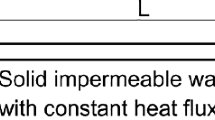Abstract
The flow of a compressible, isothermal gas under slightly rarefied conditions in a 2D planar geometry is considered. The gas is shear driven and is also subject to an applied pressure gradient, which is also known as Couette–Poiseuille (CP) flow. In this paper, the full Navier-Stokes (NS) equations are solved using a perturbation expansion up to the first order. The pressure profile is solved numerically. On the basis of the solutions, effects of rarefaction and compressibility on the flow characteristics are investigated in detail. The results show the parallel flow assumption to be invalid for cases with slight rarefaction. The axial and vertical velocity components are found to depend on the degree of rarefaction, applied pressure gradient and wall velocity. The effects of rarefaction on the occurrence of back flow are also discussed. In addition, the results for the Poiseuille and CP flow with and without rarefaction can be easily obtained from our results.







Similar content being viewed by others
Abbreviations
- H :
-
microchannel height
- K n :
-
Knudsen number
- K o :
-
outlet Knudsen number
- L :
-
microchannel length
- M :
-
Mach number
- p :
-
pressure
- P :
-
pressure ratio of inlet to outlet
- R :
-
Reynolds number
- T :
-
temperature
- u :
-
streamwise velocity
- u w :
-
wall velocity
- υ:
-
vertical velocity
- α:
-
parameter for simplicity, α = (ɛ R)/(γ M 2)
- γ:
-
ratio of specific heat
- ɛ:
-
ratio of channel height to length (perturbation parameter)
- μ:
-
viscosity
- ρ:
-
density
- σ:
-
streamwise momentum accommodation factor, σ = (2 − σ m ) /σ m
- σ m :
-
tangential momentum accommodation coefficient
- ℜ:
-
ideal gas constant
- o:
-
outlet
- 0,1:
-
orders for perturbation solution
- \(\widetilde{{}}\) :
-
nondimensional symbol
- \(\bar{{}} \) :
-
area average symbol at outlet
References
Arkilic EB, Schmidt MA, Breuer KS (1997) Gaseous slip flow in long microchannels. JMEM Syst 6:167–178
Arkilic EB, Breuer KS, Schmidt MA (2001) Mass flow and tangential momentum accommodation in silicon micromachined channels. J Fluid Mech 437:29–43
Barber RW, Emerson DR (2006) Challenges in modeling gas-phase flow in microchannels: from slip to transition. Heat Transf Eng 27(4):3–12
Beskok A, Karniadakis GE, Trimmer W (1996) Rarefaction and compressibility effects in gas microflows. ASME J Fluids Eng 118:448–56
Burden RL, Faires JD (2001) Numerical analysis (7th). Prindle Weber and Schmidt, Boston
Colin S (2005) Rarefaction and compressibility effects on steady and transient gas flows in microchannels. Microfluid Nanofluid 1:268–279
Colin S, Lalonde P, Caen R (2004) Validation of a second-order slip flow model in rectangular microchannels. Heat Transf Eng 25(3):23–30
Gad-el-Hak M (1999) The fluid mechanics of microdevices—the Freemann scholar lecture. J Fluids Eng 121:5–33
Guderley KG, Hsu CC (1973) A special form of Galerkin’s method applied to heat transfer in plane Couette-Poiseuille flows. J Comput Phys 11:70–89
Homme RP, Chapman T, Bowen J (1986) Laminar compressible flow in a tube. Appl Sci Res 43:67–74
Jang J, Wereley ST (2004) Pressure distributions of gaseous slip flow in straight and uniform rectangular microchannels. Microfluid Nanofluid 1:41–51
Karniadakis GE, Beskok A (2002) Microflows: fundamentals and simulation. Springer, Berlin Heidelberg New York
Lund KO, Bush WB (1980) Asymptotic analysis of plane turbulent Couette–Poiseuille flows. J Fluid Mech 96:81–104
Marques JW, Kremer GM, Sharipov FM (2000) Couette flow with slip and jump boundary conditions. Continuum Mech Thermodyn 12:379–386
Soong CY, Wang SH (2003) Theoretical analysis of electrokinetic flow and heat transfer in a microchannel under asymmetric boundary conditions. J Colloid Interface Sci 265:202–213
Van den Berg H, Seldam C, Gulik P (1993) Compressible laminar flow in a capillary. J Fluid Mech 246:1–20
Xue H, Ji HM, Shu C (2001) Analysis of micro-Couette flow using the Burnett equations. Int J Heat Mass Transf 44:4139–4146
Xue H, Ji H, Shu C (2003) Prediction of flow and heat transfer characteristics in micro-couette flow. Microscale Thermophys Eng7(2):51–68
Acknowledgments
The authors are very grateful for the support of Natural Science Foundation of China under Grant No. 10472054 and SRFDP under Grant No. 20040003070.
Author information
Authors and Affiliations
Corresponding author
Rights and permissions
About this article
Cite this article
Zahid, W.A., Yin, Y. & Zhu, KQ. Couette–Poiseuille flow of a gas in long microchannels. Microfluid Nanofluid 3, 55–64 (2007). https://doi.org/10.1007/s10404-006-0108-5
Received:
Accepted:
Published:
Issue Date:
DOI: https://doi.org/10.1007/s10404-006-0108-5




